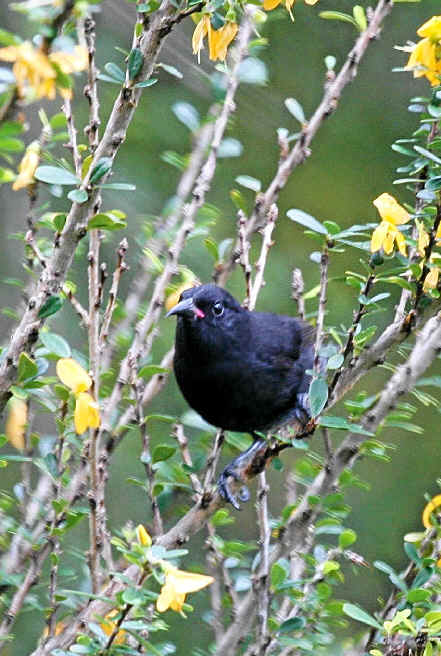
E-mail: font@focusonnature.com
Phone: Toll-free in USA 1-800-721-9986
or 302/529-1876; Fax: 302/529-1085
 |
PO Box 9021,
Wilmington, DE 19809, USA E-mail: font@focusonnature.com Phone: Toll-free in USA 1-800-721-9986 or 302/529-1876; Fax: 302/529-1085 |
THE
FOCUS ON NATURE TOUR IN THE LESSER ANTILLES
(in
Saint
Lucia, Saint Vincent, and Dominica)
December 2007/January
2008

A female Antillean Crested
Hummingbird
photographed during the
Dec '07/Jan '08 FONT tour in the Lesser Antilles
(photo by Marie Gardner)
Links:
List
of Birds during our Lesser Antilles Tour - Dec '07 / Jan '08
Cumulative List of Birds during FONT tours in the Lesser Antilles
Cumulative List of Birds during FONT tours in the Caribbean (with photos)
Upcoming FONT Caribbean Birding & Nature Tours
The following narrative was written by Armas Hill, leader of the tour:
Our FONT
Annual Holiday Tour for Dec/Jan 2007/2008 was to the Caribbean
islands of Saint Lucia, Saint Vincent, and Dominica. During the last days of 2007, we were in
Saint Lucia & Saint Vincent.
Our birding during the first days of 2008 was in Dominica.
Each of the three Lesser Antillean islands just mentioned has, in relation to
birds, something in common. And that is that Parrots, in particular Amazons,
endemic to those islands, continue to live there.
At the time of Columbus's voyages in the Caribbean, there were, on various
islands, 11 species of Amazon parrots, and even on some islands, macaws,
larger than parrots. No macaws exist any longer on any Caribbean
island. They were on various islands in both the Lesser and the Greater
Antilles. The last of the Caribbean macaws disappeared in Cuba in the mid-1800s.
Of the 11 species of Amazons that existed in Columbus's time, 2 are now extinct (one
each on the two French islands of Guadeloupe and Martinique), and 1 is
severely endangered (on Puerto Rico).
Overall, however, (aside from the Puerto Rican Amazon),
the species that have been in the most peril have been those in the Lesser
Antilles.
The rare Imperial Parrot, Amazona imperialis, of Dominica
(known there as "the Sisserou") has a plumage that resembled
the Amazon now extinct on the nearby island of Guadeloupe. It's the largest of
all the Amazon parrots. In the Western Hemisphere, there are 31 species of
Amazons in the Caribbean and in Central & South America. The Imperial Parrot
was one of the last Amazons described to science, and one of the last birds to
be described in the Nineteenth Century, in 1899.
Dominica's Imperial Parrot is rare. Not ever common, it was
declining until the 1990s. At the beginning of that decade, the total population
was said to be 50 birds. Through the 1990s, there was an increase, until today,
when it's said that are about 250 individuals.
The other Amazon that's endemic to Dominica is the Red-necked Parrot, Amazona
arausiaca. That attractive parrot is also called the "Bouquet's
Amazon". In Dominica, it's known, by the local people, as either the "Jaco"
or the "Perroquet". It was described to science as early as
1776. Today, the population of Red-necked Parrots is said to be between
500 and 1,000 birds.
During our Dec 07/Jan 08 tour in the Lesser Antilles we saw both the Imperial
and the Red-necked Parrots when we were in Dominica (in January), and
both the Saint Lucia and the Saint Vincent Parrots when we were on
those islands (in December).
The Saint Lucia Parrot, Amazona versicolor, is known to the
people on that island as the "Jacquot". It is the national bird
of that island country. The children are taught about it in school, and nearly
all of the people with whom we spoke on the island knew of the bird. The
educational program in the schools was initially carried out by a friend of ours
that we used to meet during our St. Lucia tours in the 1990s, when he lived in
that country. He no longer does, but we have good memories of Paul Butler, who,
for years, was affiliated with the conservation organization known as RARE.
Even though we weren't able to see Paul, during this our 15th FONT tour on Saint
Lucia, we saw, once again, as we always have, the Saint Lucia
Parrot flying about late in the day in the forested hills.
The total population of the Saint Lucia Parrot is now said to be between
350 and 500 birds. It can safely be said that conservation efforts, as those
just alluded to, have saved this species from extinction.
Maybe the Amazon that we enjoyed the most during our 07/08 Holiday Tour
was the Saint Vincent Parrot, Amazona guildingii.
Another name for it has been the "Guilding's Amazon".
Whatever it's called, it's a brilliantly colorful bird with some white, yellow,
blue, and bright orange-yellow in its plumage. Its habitat is moist forest in
the hills.
During most of the 20th Century, the population of the bird declined. In the
1980's, it was as low as about 400 birds. Since then, with conservation efforts,
the population has increased to now maybe about 800 individuals.
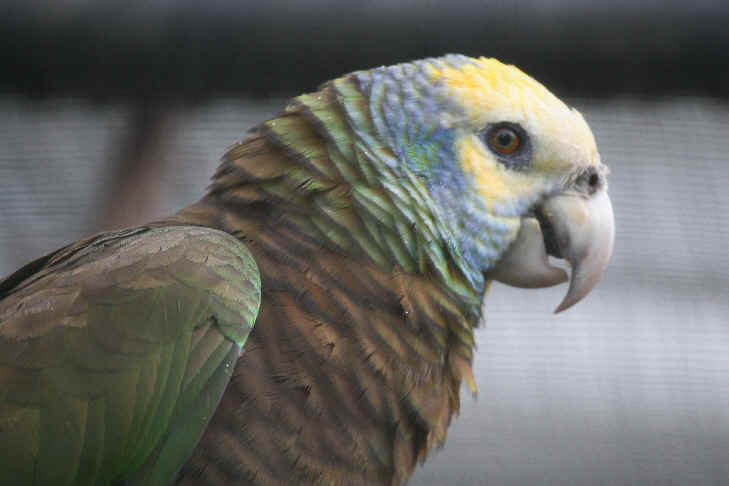

The colorful
Saint Vincent Amazon,
photographed during the FONT tour in December 2007.
Above: a captive bird in the botanical garden.
Below: in the wild, in the forest.
(photos by tour participant, Marie Z. Gardner)
While in Saint
Vincent, we visited a places called Vermont
and Montreal. No, Vermont wasn't a
place with maple syrup and ski slopes. And no, Montreal was not a large city.
Vermont (or "Green Mountain") was
where we saw the parrots, and some other birds too, in what was a moist
forest when we were there. But, yes, we did enjoy seeing those parrots
flying about in the wild, and even perched closely in a nearby tree, after the
rain stopped and as the late-afternoon sun brilliantly shone on the birds.
Montreal was not really too far from
Vermont. It was actually on the "other side" of the hills from the
parrot. I say "Montreal", but it was actually Montreal Gardens, a nice
place with some nice birds including the Lesser Antillean Tanager (a
species restricted to only the two Lesser Antillean islands of Saint Vincent
& Grenada), and rare Whistling Warbler (endemic to Saint
Vincent), and the Brown Trembler (an aberrant thrasher
with yellow eyes and a long bill that appears to "tremble" as
it continually shakes its wings).
Some other places where we were on St. Vincent are worth a mention. Our
overnights were in the largest town on the island (but not really large)
- Kingstown. The neat old cobblestone building near the port was, years ago, a
sugar warehouse. In the 1970s it was made into a nice hotel. We were there on
New Year's Eve, and even though we were in town, it was about as quiet a place
for New Year's Eve as there could be.
Nearby, earlier on New Year's Eve, we had an evening bite to eat at an outside
courtyard of another hotel, the Heron Hotel. As we ate, a Green Heron
walked by, next to us, in what was not much more than a little drainage ditch.
Across the street, a Little Blue Heron flew into a tree. Evidently, that
hotel, in the middle of Kingstown, was aptly named.
A day or so earlier, there was still an air of Christmas, as we went about.
Again in Kingstown, outside an old church, in the churchyard, as we observed a
few species of birds, the congregation, inside the church, beautifully sang a
Christmas hymn. It was a nice touch during our annual "Holiday Tour".
At the already-mentioned Montreal Gardens, and growing wild elsewhere as well,
there were bright red Poinsettia plants, adding even more to the season, even
though we were far away from winter, on a tropical island.
On the other tropical island where we stayed, St. Lucia,
there were some notable settings and sights. Of course, the two tall Pitons (or
peaks) were overwhelmingly scenic. And the Saint Lucia Oriole (an
endemic) was also a nice sight.
For some, maybe the best setting of the tour, was atop a particular high cliff
by a lighthouse. In hefty winds at that place, there were as many as 50
Red-billed Tropicbirds in fast flight, both above us and below us by the
cliff. Noisy they were, calling as they flew. Being with those extraordinary
birds, that are often far out at sea, was certainly one of tour's highlights.
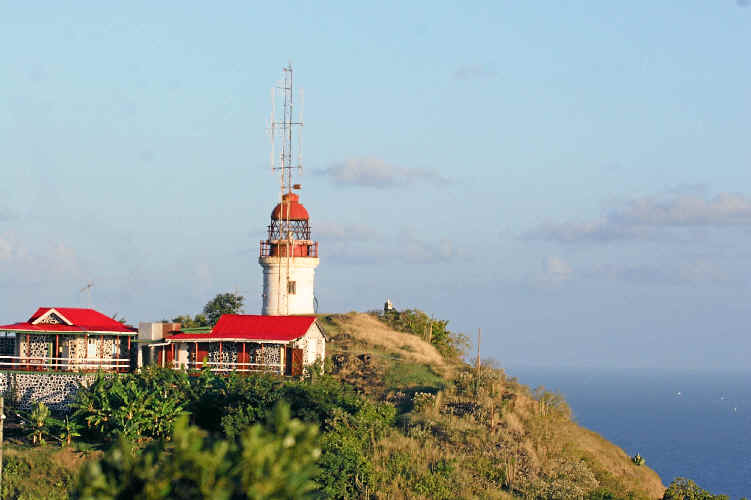
Above: A lighthouse atop a
cliff in Saint Lucia.
Below: One of a few dozen Red-billed Tropicbirds below the cliff.
(photos by Marie Gardner during the Dec 2007 FONT tour)
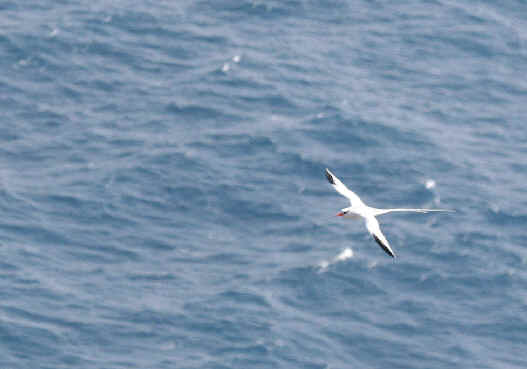
At another point during our tour, as we were in the van on St.
Vincent, the subject somehow came up of the movies "The
Pirates of the Caribbean". Apparently, there were 3 such movies,
and they were filmed on St. Vincent and Dominica
(two of the islands included in the itinerary of our tour). Anyway,
our driver then told us that we were in the same van, and the same seats, used
by the cast of the movie. One of us was where Johnny Depp sat. Another was in
the sea where Keira Knightley was, and another in the one used by Orlando Bloom.
Of course, a name for our tour was close to that of the movie. We came to see "The
Parrots of the Caribbean", and that we did.
And it was wonderful doing so, as it was seeing others of the avian cast - the hummingbirds,
the thrashers & tremblers, the solitaire (with its
beautiful song), the Warblers (Whistling, Plumbeous,
& St. Lucia) the frigatebirds & boobies (that
were flying about by the "Pirates of the Caribbean" movie set that we
visited ), and the bananaquits and bullfinches that would fly
into our rooms when we'd leave the doors open.
In all, we had a enjoyable tour, during which we saw some birds that are rare,
and others with a restricted range that's just a small dot on the global map.
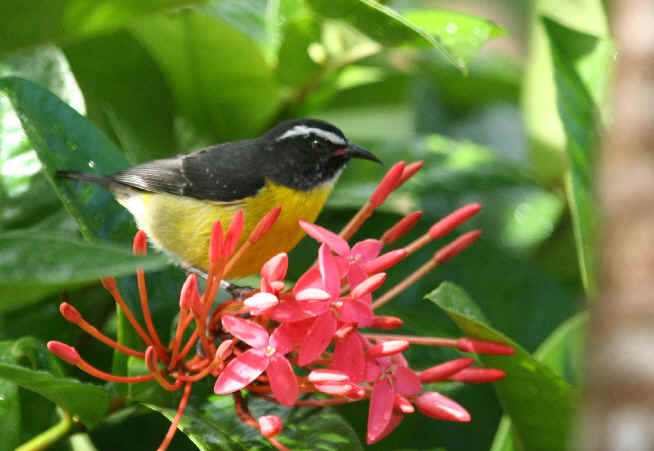
Throughout
much of the New World,
and particularly in the Caribbean,
there are a number of subspecies of Bananaquits.
That number is 41.
The Bananaquit on the island of Saint Lucia (above)
is quite different than the all-black form (below)
on the nearby island of St Vincent.
